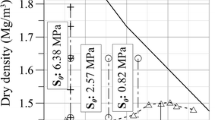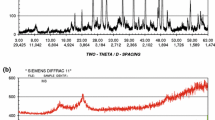Abstract
Design in swelling mediums is mostly based on uniaxial data since the standards proposed by the International Society for Rock Mechanics Commission on Swelling Rocks for uniaxial tests are in the form of recommendations, triaxial sets are not highly available; and there is no standard developed for triaxial tests. The main purpose of this study is to define the relationship between the uniaxial and the triaxial swelling equations and to predict the triaxial values using the uniaxial data. The other purpose of the study is to contribute to the development of the standards and to expand the data available in the literature about triaxial swelling behavior. Numerous uniaxial and triaxial swelling tests were performed on the samples from seven different locations, in Turkey, in a state of the art swelling laboratory. As a result of the determination of the triaxial swelling behavior of these samples, the relationships between the uniaxial and the triaxial swelling data for the individual samples as well as the whole set of samples are expressed by the equations derived from the statistical analyses.











Similar content being viewed by others
References
Aiban SA (2006) Compressibility and swelling characteristics of Al-Khobar Palygorskite, eastern Saudi Arabia. Eng Geol 87:205–219
Alonso EE, Olivella S (2008) Modelling tunnel performance in expansive gypsum claystone. The 12th international conference of international association for computer methods and advances in geomechanics (IACMAG), Goa, India, pp 891–910
Al-Shamrani MA (2004) Influence of lateral restraint on the swelling behavior of expansive soils. Geotech Eng (J Southeast Asian Geotechn Soc) 35(3):101–111
Anagnostou G (1993) A model for swelling rock in tunneling. Rock Mech Rock Eng 26:307–331
Anagnostou G, Pimentel E, Serafeimidis K (2010) Swelling of sulphatic claystones—some fundamental questions and their practical relevance. Fifty-ninth Geomechanics Colloquy, Zurich, p 12
Anderson RL, Ratcliffe I, Greenwell HC, Williams PA, Cliffe SP, Coveney V (2010) Clay swelling—a challenge in the oilfield. Earth Sci Rev 98:201–216
ASTM (2000) Annual book of ASTM standards—soil and rock, building stones. Section 4, Construction, v. 04.08. ASTM, Philadelphia
Aydan Ö, Ito T, Akagi T, Kawamoto T (1994) Theoretical and numerical modeling of swelling phenomenon of a rocks in rock excavations. In: Siriwardane HJ, Zaman MM (eds) Computer methods and advanced in geomechanics. A.A Balkema, Rotterdam, pp 2215–2220
Barla M, (1999) Tunnels in swelling ground—simulation of 3D stress paths by triaxial testing laboratory. (PhD Thesis), Politecnico di Torino
Barla G, Barla M, Perino A (2009) Pavoncelli tunnel case study. In: Diederichs M, Grasselli G (eds) Proceedings of the 3rd CANUS rock mechanics symposium, Torino, Italy, p 12
Berdugo de Moya IR, Alonso E, Romera Morales E, Gens Solé A (2009) Tunnelling and swelling in Triassic sulphate-bearing rocks. Revista Épsilon 12:13–37
Bilir ME (2011) Swelling problems and triaxial swelling behavior of claystone: a case study in Tire, Turkey. Sci Res Essays 6(5):1106–1116
Bilir ME, Muftuoglu YV (2002) Swelling test apparatus (in Turkish), ROCKMEC’2002–VIth regional rock mechanics symposium, Konya, Turkey, pp 155–162
Bilir ME, Sari D, Muftuoglu YV (2008) A computer-controlled triaxial test apparatus for measuring swelling characteristics of reconstituted clay-bearing rock. Geotech Test J 31:1–6
Bilir ME, Sari YD, Muftuoglu YV, Donmez S (2012) Clay content effects on triaxial swelling characteristics of clay-bearing samples. Energy Educ Sci Technol A Energy Sci Res 29(2):837–850
Brattli B, Broch E (1995) Stability problems in water tunnels caused by expandable minerals. Swelling pressure measurements and mineralogical analysis. Eng Geol 39:151–169
Butscher C, Huggenberger P, Zechner E (2011) Impact of tunneling on regional groundwater flow and implications for swelling of clay–sulfate rocks. Eng Geol 117:198–206
Doostmohammadi R, Moosavi M, Arabi BN (2008) A model for determining the cyclic swell–shrink behavior of argillaceous rock. Appl Clay Sci 42:81–89
Einstein HH (1996) Tunneling in difficult behavior and identification of ground-swelling swelling rock. Rock Mech Rock Eng 29:113–124
Franklin JA (1984) A ring swell test for measuring swelling and shrinkage characteristics of rock. Int J Rock Mech Min Sci Geomech Abstr 21:113–121
Goel RK, Swarup A (2006) A case history of tunnelling through difficult ground. Tunn Undergr Space Technol 21:362
Gundogdu MNG (1982) Geological, mineralogical and geochemical investigation of the Neogene aged Bigadic sedimentary basin. PhD Thesis, Department of Geological Engineering, Hacettepe University, Ankara, Turkey (in Turkish), p 386
Gysel M (1977) A contribution to the design of a tunnel lining in swelling rock. Rock Mech 10:55–71
Harper TR, Appel G, Pendleton MW, Szymanski JS, Taylor RK (1979) Swelling strain development in sedimentary rock in Northern New York. Int J Rock Mech Min Sci Geomech Abstr 16:285–288
Hawlader BC, Lee YN, Lo KY (2003) Three dimensional stress effects on time-dependent swelling behaviour of shaly rocks. Can Geotech J 40:501–511
Huang SL, Aughenbaugh NB, Rockaway JD (1986) Swelling pressure studies of shales. Int J Rock Mech Min Sci Geomech Abstr 23(5):371–377
Huder J, Amberg G (1970) Quellang in Mergel, opalinuston und anhydrit experimental studies on the mechanical behaviour of two thermal cracked marbles. Schweizerische Bauzeitung Rock 83:975–980
Ismaiel HAH, Makhloof AA, Mahmoud AA, Galal AA (2012) Geotechnical behavior of pliocene sedimentary rocks exposed along Qena-Safaga road at Qena region. Int J Min Eng Miner Process 1(2):84–93
ISRM (1983) Characterization of swelling rock. Commission on Swelling Rock. Pergamon Press, Oxford
ISRM (1994) Comments and recommendations on design and analysis procedures for structures in argillaceous swelling rocks. Int J Rock Mech Min Sci Geomech Abstr 31(5):535–546
Johnson LD, Snethen DR (1978) Prediction of potential heave of swelling soils. Geotech Test J 1:117–124
Jones DE, Holtz WG (1973) Expansive soils—the hidden disaster. Civ Eng ASCE 43(8):49–51
Kovári K, Chiaverio F (2007) Modular yielding support for tunnels in heavily swelling rock. In: Proceedings preprint STUVA conference `07, Köln, pp 1–7
Li SL, Qin SJ, Bo ZZ, Shi B (1992) Studies on the engineering geology of expansive soils in China. Jiangsu Science and Technology Publishing House, Nanjing, pp 212
Madsen FT (1999) Suggested methods for laboratory testing of swelling rocks. Int J Rock Mech Min Sci Geomech Abstr 36:291–306
Madsen FT, Müller-Vonmoos M (1985) Swelling pressure calculated from mineralogical properties of a jurassic opalinum shale, Switzerland. Clays Clay Miner 33(6):501–509
Madsen FT, Flückiger A, Hauber L, Jordan PA, Voegtli B (1995) New investigations on swelling rocks in the Belchen Tunnel, Switzerland. 8th Int Congr Rock Mech 1:263–267
Mao D, Nilsen B, Lu M (2011) Analysis of loading effects on reinforced shotcrete ribs caused by weakness zone containing swelling clay. Tunn Undergr Space Technol 26:472–480
Meisina C, Zucca F, Fossati D, Ceriani M, Allievi J (2006) Ground deformation monitoring by using the permanent scatterers technique: the example of the Oltrepo Pavese (Lombardia, Italy). Eng Geol 88:240–259
Nakano R, Shimizu H, Nishimura S (1996) Cause of swelling phenomena in tunneling and a proposal for a design procedure for a swelling tunnel. Soils Found 36:101–112
Nilsen B (2011) Cases of instability caused by weakness zones in Norwegian tunnels. Bull Eng Geol Environ 70(1):7–13
Nilsen B, Ballou BJ (2006) Stability problems and rock support at the Tellnes open pit mine, Norway. The South African Institute of Mining and Metallurgy International Symposium on Stability of Rocks Slopes, 155–165
O’Neil MW, Ghazzally OI (1977) Swell potential related to building performance. J Geotech Eng Div ASCE 103(GT12):1363–1379
Ozer M, Ulusay R, Isik NS (2012) Evaluation of damage to light structures erected on a fill material rich in expansive soil. Bull Eng Geol Environ 71:21–36
Pejon OJ, Zuquette LV (2006) Effects of strain on the swelling pressure of mudrocks. Int J Rock Mech Min Sci 43:817–825
Pellissier JP, Vogler UW (1990) A contribution to the explanation of the behaviour of swelling rock. In: Brummer R (ed) Static and dynamic consideration in rock engineering. A.A. Balkema, Rotterdam, pp 241–250
Pérez-Romero J, Oteo CS, de la Fuente P (2007) Design and optimization of the lining of a tunnel in the presence of expansive clay levels. Tunn Undergr Space Technol 22:10–22
Pipkin BW, Trent DD (1994) Geology and the environment. West Publishing Corporation, West Minneapolis, MN
Sadisun IA, Shimada H, Ichinose M, Katsui K (2002) An experimental study of swelling strain in some argillaceous rocks by means of an improved unconfined swelling test. In: Choi, Ryu, Jeon & Moon (eds) Rock engineering problems and approaches in underground construction, pp 227–234
Shakoor A, Sarman R (1992) Swelling potential classification of mudrocks based on geotechnical properties. In: Hudson JA (ed), ISRM symposium: Eurock’92 rock characterization, pp 74–80
Steiger RP (1993) Advanced triaxial swelling tests on preserved shale cores. Int J Rock Mech Min Sci Geomech Abstr 30(7):681–685
Steiner W, Kaiser PK, Spaun G (2010) Role of brittle fracture on swelling behaviour of weak rock tunnels: hypothesis and qualitative evidence. Geomech Tunn 3(5):1–16
Tabrizian MG (1993) The investigation of engineering properties and characteristics of three-dimensional swelling of Goynuk Base claystone. (Master of Science Thesis), HU Institute of Science, Department of Mining Engineering, p 83
Tang AM, Cui YJ, Trinh VN, Szerman Y, Marchadier G (2009) Analysis of the railway heave induced by soil swelling at a site in southern France. Eng Geol 106:68–77
van Oort E (2003) On the physical and chemical stability of shales. J Petrol Sci Eng 38:213–235
Vijayvergiya VN, Ghazzaly OI (1973) Prediction of swelling potential of natural clays. In: Proceedings, 3rd international research and engineering conference on expansive clays, pp 227–234
William E, Airey DW (2004) Index properties and the engineering behaviour of Bringelly shale. The engineering geology of the Sydney region-revisited. AGS Sydney chapter mini-symposium, No. 3, vol 39, pp 31–42
Windal T, Shahrour I (2002) Study of the swelling behavior of a compacted soil using flexible odometer. Mech Res Commun 29:375–382
Wittke-Gattermann P, Wittke M (2004) Computation of strains and pressures for tunnels in swelling rocks. Thirtieth ITA-AITES World Tunnel Congress. Singapore, pp E14 1–E14 8
Wong RCK, Wang EZ (1997) Three-dimensional anisotropic swelling model for clay shale—a fabric approach. Int J Rock Mech Min Sci Geomech Abstr 34:187–198
ISRM (1989) Suggested methods for laboratory testing of argillaceous swelling rocks. Int J Rock Mech Min Sci Geomech Abstr 26(5):415–426
Yeşil MM (1991) Determination of three dimensional swelling characteristics of clay bearing rocks. Ph.D. Thesis, Middle East Technical Univ., Ankara, Turkey, pp 109
Yeşil MM, Paşamehmetoğlu AG, Bozdağ T (1993) A triaxial swelling test apparatus. Int J Rock Mech Min Sci Geomech Abstr 30:443–450
Yilmaz I (2006) Indirect estimation of the swelling percent and a new classification of soils depending on liquid limit and cation exchange capacity. Eng Geol 85:295–301
Acknowledgments
The authors sincerely thank the TUBITAK (Scientific and Technical Research Council of Turkey, Project No: 104M198) and Bulent Ecevit University for financial support and two anonymous reviewers for their valuable recommendations.
Author information
Authors and Affiliations
Corresponding author
Rights and permissions
About this article
Cite this article
Bilir, M.E., Sarı, Y.D., Özarslan, A. et al. Determination of the relationship between uniaxial and triaxial swelling equations for clay bearing rocks. Bull Eng Geol Environ 72, 565–577 (2013). https://doi.org/10.1007/s10064-013-0523-2
Received:
Accepted:
Published:
Issue Date:
DOI: https://doi.org/10.1007/s10064-013-0523-2




